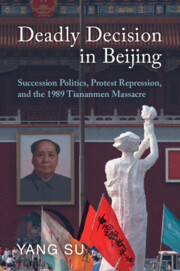Book contents
- Deadly Decision in Beijing
- Deadly Decision in Beijing
- Copyright page
- Epigraph
- Contents
- Figures
- Tables
- Preface
- Acknowledgments
- Main Characters
- Chronology
- Abbreviations
- 1 Introduction
- Part I Party-State Leadership in the Deng Era
- Part II Elite Politics and the Making of the Tiananmen Protest
- 4 Early Response and the Growth of the Protest
- 5 Where Was Deng Xiaoping?
- 6 How a Moderate Approach Failed
- Part III The Decision for Military Intervention
- Part IV The Political Impact
- Notes
- Index
6 - How a Moderate Approach Failed
April 26–May 17, 1989
from Part II - Elite Politics and the Making of the Tiananmen Protest
Published online by Cambridge University Press: 23 February 2023
- Deadly Decision in Beijing
- Deadly Decision in Beijing
- Copyright page
- Epigraph
- Contents
- Figures
- Tables
- Preface
- Acknowledgments
- Main Characters
- Chronology
- Abbreviations
- 1 Introduction
- Part I Party-State Leadership in the Deng Era
- Part II Elite Politics and the Making of the Tiananmen Protest
- 4 Early Response and the Growth of the Protest
- 5 Where Was Deng Xiaoping?
- 6 How a Moderate Approach Failed
- Part III The Decision for Military Intervention
- Part IV The Political Impact
- Notes
- Index
Summary
Chapter 6 returns to focus on Zhao Ziyang and Li Peng, covering the time from the April 26 editorial until the outbreak of the hunger strike on May 13 and the martial law decision on May 17. A moderate approach failed due to both lack of sincereity and elite conflcit.
- Type
- Chapter
- Information
- Deadly Decision in BeijingSuccession Politics, Protest Repression, and the 1989 Tiananmen Massacre, pp. 114 - 140Publisher: Cambridge University PressPrint publication year: 2023

